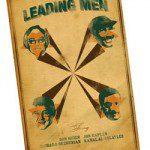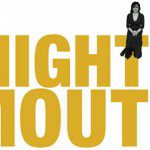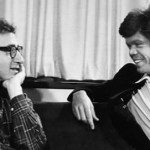Birth of The Agenda
A new CEO, a new corporate mandate, fewer staff and less money for programming are all part of a messy upheaval at TVOntario. Despite the tumult, Steve Paikin and team have created an unlikely journalistic success story
Steve Paikin is nervous. It’s a few days before the debut of TVO’s new current affairs show, The Agenda With Steve Paikin. He has spent months preparing for the show, not to mention pursuing the man who now sits in front of him for an interview. The show has made some accommodations to land this coveted guest: despite the fact that it’s supposed to go live every night, this segment is being pre-taped. The charcoal grey of Paikin’s suit complements the blues and greys of his new studio. He clutches his questions and his pen. Paikin’s living every interviewer’s dream. The first guest on his new show is none other than the notoriously outspoken and opinionated Conrad Black, the former press baron who faces 14 charges including mail-and-wire fraud, racketeering and tax evasion.
Paikin doesn’t waste any time wading into Lord Black’s legal difficulties. Black often jumps in before Paikin has a chance to finish a question.
“I heard you say there are delicate negotiations in place,” says Paikin, “and I’ve also heard you say you want your day in court.”
Lord Black curtly replies, “Yes.”
“The first suggests there’s going to be a plea bargain before it gets to court….”
“No, no, no, no, no, no.”
“No?” asks Paikin.
A few minutes later, despite renouncing his Canadian citizenship in 2001 so that he could join the British House of Lords, Black announces he wants his citizenship back.
The show airs September 25, 2006 and the next day Lord Black’s desire to renew his Canadian citizenship is all over the news — and so is The Agenda. In fact, it can’t get much better for the new show, which has risen from the ashes of the now defunct Studio 2, taking over its Monday to Friday, 8 to 9 p.m. timeslot.
At the next morning’s daily meeting, the producers and Paikin gather around The Agenda’s boardroom table. They exchange congratulations for a job well done. While the staff considers the first show a success, everyone realizes they have to produce a high-quality episode every night. Shows become hits by being consistently excellent and attention-grabbing, but considering how low the morale has been at TVOntario over the past few months, they’ll take the initial victory.
Paikin believed they could create something great with his new show, a belief that helped him stare down the question he met everywhere he went in the province: “What were they thinking cancelling Studio 2?” In the time between June 29, 2006, Studio 2’s last episode, and The Agenda’s premiere, a new roster had to be hired, including producers drawn from Studio 2 employees, as well as others from around the broadcaster’s offices. It had taken time for the team to find its rhythm, and both executive producer Dan Dunsky and Paikin were putting in long days. Because the show was created in controversial circumstances, there’s that much more pressure to succeed — pressure to succeed under reduced budgetary circumstances.
The death of Studio 2 and the birth of The Agenda can be traced back to an internal company report called “Reaching Beyond: Strategic Agenda 2006,” which was approved by Lisa de Wilde, TVO’s CEO. The report was a reality check: TVO needed to modernize and upgrade its technology, and fast. The execution of the report’s recommendations — making changes through a mixture of one-time grants and cuts — led to Studio 2’s demise. During its 12-year run, the program won several awards, including the Gemini in 2003 for Best Talk Series, and by commercial television standards was produced relatively cheaply — but not cheaply enough for a public broadcaster falling behind technologically and in need of a quick fix. For reasons that included the program not being cost-effective enough, it was euthanized.
Paikin’s new show would be cheaper to produce — for one thing, it would have one fewer host, as Studio 2’s Paula Todd was not invited to participate (her new show, Person 2 Person With Paula Todd, a spin-off of aStudio 2 segment, airs Fridays at 10 p.m.). For another, guests would come into the studio rather than producers going into the field. But the new scheme, which gave Paikin more creative control, had drawbacks. It meant fewer staff and longer hours, and the way the new structure worked it seemed like they had to perform cartwheels every weekday — if Paikin went down, there had to be an emergency list of back-up hosts.
But on the triumphant first night, the anxieties associated with the transition from Studio 2 to The Agendawere behind Paikin and his producers. Not only had they dodged a bullet, they’d returned fire and silenced cynics and critics alike. Dunsky attempted to rein in the team’s excitement: “Let’s not let this go to our heads, guys.”
Dunsky has the world at his feet. Two worlds, in fact: on the floor behind his constantly swivelling office chair, two framed maps of the world are waiting to be mounted on the wall. He’s only been in this office for a short time, but his political paraphernalia is already in place, including a black and white photograph of former U.S. president Franklin D. Roosevelt, a communist Chinese military cap, and American and Canadian flags side by side. “The world is a phenomenally interesting place,” Dunsky says, sweeping his arms and twisting around in his chair to take in his room. “And it’s in a constant state of change.”
So is the place he works for. The man now responsible for TVO’s flagship current affairs show, Dunsky has watched the provincially funded broadcaster go through enormous changes over the past year. His new office and his promotion to executive producer are two results of this tumult. He now works next door to Paikin, his host and fellow current affairs junkie, at TVOntario headquarters in midtown Toronto.
When Dunsky leans back in his chair, he scans the office bustle through a large glass wall. What he sees are the offices and cubicles where some of his producers help put the show together. Just beyond his view is a large boardroom table where story meetings are held every morning. It was only a year ago that Dunsky was the producer of “Diplomatic Immunity With Steve Paikin,” a program he co-created with Paikin eight years ago. The show aired as part of Studio 2 during its final season, and consisted of regular panel members discussing the hot political topics of the day. He had also been a series producer of the TVO program Big Ideas.
Dunsky plunks a foot on his desk and lets it rest near a pile of books and papers that appear not to have been touched for days. Poking out of the bottom, decorated with bold red lines, is the Strategic Agenda. It’s one of the main reasons Dunsky is where he is and why there is a new show in the first place.
Back in September 2005, the Ontario Ministry of Education announced that it wanted TVOntario to review its operations after picking a new CEO. Two months later, Isabel Bassett stepped down and de Wilde took over. She had an impressive resumé — in 2001 she was celebrated in the Financial Post’s Power 50 as one of Canada’s most influential corporate women. She was president and CEO of Astral Television Networks from 1993 until 2001, and a practicing lawyer from 1989 to 1993. De Wilde was not only involved in the development of the Strategic Agenda, it was also her job to follow through and tighten the budget. One month into her new position, she assembled a committee of TVO management that began a strategic review of the organization, which ended with the report that called for serious change. Over the past 10 years, TVOntario has limped along on a stagnant government base grant of approximately $45 million per year. Even with the $7 million to $8 million in pledges the station receives annually, other lesser government grants, and corporate funding, the broadcaster has been without the means to evolve, expand or modernize. It all added up to just over $76 million in 2005.
If it’s any consolation, TVOntario is fairly well off compared to the other four provincial public broadcasters. TVOntario and Télé-Québec, which had a revenue of $73.4 million in 2006, are the Cadillacs. British Columbia’s and Saskatchewan’s had 2006 revenues of $10.6 and $9.3 million respectively. Alberta’s operates on radio only. The other main difference is that TVO produces more original programming than the others.
According to the Strategic Agenda, however, TVO’s problems could not be explained away entirely by citing financial woes. It wasn’t just a case of their main government grant remaining the same for a decade. The stiff increase in media competition and the diversifying market both required immediate attention. TVO competes against big corporations such as CTV and Global, as well as the national public broadcaster, CBC, and innumerable channels available to cable and satellite subscribers.
With broadcasters adding interactive media — one example is Kevin Newman’s Global National being available as a nightly podcast — TVO had to evolve if it wanted to continue to be relevant and competitive. To do this, the ministry gave the station a one-time grant of $25.4 million, to be used over two years. Of that, $10 million is earmarked to convert TVO’s production facilities from analog to digital technology. The remaining sum is to help support TVO as it makes the transition into new media and builds its revenue streams. So far, TVO has begun to expand its reach into cellphone downloads, podcasts and other interactive media.
To support the digital expansion while continuing regular programming, the Strategic Agenda advised considerable financial shuffling: “The cost base of the organization must be reduced.” This is why Dunsky and the rest of TVO’s staff found themselves packing and unpacking personal effects — the office space was shrinking. Another initiative was to separate TVO from its long-time network partner, TV Français Ontario. Soon TFO will have its own board of directors, its own control over programming and its own budget worries. Many of these efficiency-seeking changes would be invisible to the general public. More tangible to viewers would be cuts to programming, something that would affect employees on a personal and emotional level.
On June 28, 2006, Doug Grant, executive producer of Studio 2, arrived for work just before 10 a.m., weary from lack of sleep. He’d put in long hours on the show the night before. The entire time he was in the office he was inundated with media phone calls. He didn’t answer, because he knew the reason everyone was calling. For months there had been whispers and notes exchanged. Studio 2 host Paikin had written to Grant, asking if he should be looking for a new job. And in the wee hours of June 28, as Grant read the Toronto Star’s online morning edition, his fears were confirmed: Studio 2 was over.
Grant had a meeting scheduled for 10 a.m. with his boss, Nancy Chapelle, managing director of English programming services. He knew he was about to lose his job. Chapelle began speaking to Grant in a cookie-cutter corporate tone when he walked through her door. “Cut the crap,” he said.
Chapelle handed Grant his severance package and told him to assemble staff — it would be his responsibility to tell them. About a half hour later he stood in front of Studio 2’s crew, fighting back tears. By then everyone had either heard through the media or been told by a colleague. Tears flowed and tempers flared. As Grant made the official announcement, Chapelle stood and watched, deflecting harsh words and raised voices with corporate catch phrases. Grant told them: tomorrow’s live broadcast will be Studio 2’s last.
The format of Studio 2 included short documentaries, which involved sending out crews to shoot and then editing raw footage back in the studio. It’s a method that costs money to do properly. The show also included segments such as the Dunsky-produced “Diplomatic Immunity With Steve Paikin,” which often featured the same freelance panelists who received stipends for their regular contributions. Musical acts also performed, and were paid for their services (the music segments, which broadcast every Thursday night, were cut inStudio 2’s final season for financial reasons). In addition, the two big-name co-hosts, Paikin and Todd, pulled in salaries of $214,037 and $178,034 respectively.
As the program’s executive producer, Grant was in charge of the budget. In the world of television, it was a budget that was below average, especially since in its final two seasons the show achieved its projected target of 100,000 viewers per minute, meaning it had developed a loyal following province-wide. Per hour, the cost of producing Studio 2 was very reasonable — but not reasonable enough.
Sometime in April or May, before Grant’s final staff meeting, Chapelle called Paikin into her office. He had been co-host of Studio 2 since its premiere in 1994. He knew many current affairs shows didn’t last long, and believed every year might be the last. Every time his contract was about to expire, he and the director of English programming would make a lunch date. The two would talk hobbies and life for 43 minutes. Then, right before paying the bill, Paikin’s boss would ask him back and offer him a salary.
Studio 2 was about to complete its 12th season when Paikin went to Chapelle’s office. He sat in a chair facing his boss as she broke the news to him. There would be no negotiation lunch as in past years — Studio 2 had a good run, she told him, but its time was up. Without much of a pause, she then proposed that Paikin host his own show and work side by side with Dunsky, sharing production responsibilities. This project would provide him with new opportunities, including more involvement in story choice, panel selection, guest selection and other aspects of the show. He’d never been offered this level of responsibility before, and his excitement helped numb the pain.
It wasn’t as though Paikin didn’t have a choice. After moderating a 2006 federal election leadership debate, he’d become a sought-after man. Already known for his thorough research and interviewing skills, his emerging national prominence combined with the sudden death of the beloved Studio 2 created the perfect opportunity for him to take any of several offers. Yet he decided to stay with TVO. “As corny as this sounds,” he says, “I’m really quite sold on the agenda of this place, which is to look at the in-depth issues for the people of this province today.”
“I’ve never made a move for money, it just doesn’t motivate me,” Paikin continues. In the past, he says, he’s taken radio jobs that have paid $18,000 and less annually simply because they’ve met his four criteria: Is it work he loves? Is it with people he respects and likes? Is he having an impact on society? And does he believe in the organization’s mission? “I know with The Agenda I have four yeses,” he says. “I don’t know that about anywhere else.”
Sending out crews to gather new material, then having it edited back in the studio like the old days, wasn’t going to be part of the new plan. “Typically, what is expensive in television is news production,” says Dunsky. “Obviously we chose a different route with The Agenda, and the budget reflects that.” The show’s hour of current affairs programming is divided into two main parts: a 10 to 15 minute one-on-one interview followed by a debate with several panelists.
The format is simple, but painstakingly difficult to pull off night after night. Securing a fresh panel of guests who are experts on the topic up for discussion is a laborious job for the producers, and Dunsky’s team has put in 12 to 14 hour days to make the show work. The pace can be fatiguing for Paikin, which is one of the reasons why the show has an emergency list of replacement guest-hosts.
Since that first show with Lord Black, The Agenda has dealt with a wide range of subjects. Each of the show’s producers is responsible for pitching ideas and putting them into action. Back in October 2006, producer Meredith Martin, who was previously a producer on Studio 2, said there was some adjustment needed for her new role. “I’m still figuring out how to structure and pace a 35- to 40-minute discussion,” she said, “and how to make a topic meaty enough for it.”
A month later, Martin produced a show about fertility. The hour included an intense and personal discussion with people who have experienced adoption, childless lives, or struggles and successes with fertility. These professionals, including another TVO producer, spoke tearfully and candidly, creating the most human moments seen on the program up to that point.
As a current affairs show, The Agenda has dealt with the expected topics: Afghanistan, the Liberal leadership race, global warming. Story ideas, however, are not only brought forth by producers. Every Thursday, the show is dubbed “Your Agenda” and the topics covered are ones suggested by viewers. Audience members also take turns being political pundits on the show’s website. There are forums, blogs, streaming video and podcasts.
The show has received some criticism. The Toronto Star’s media columnist, Antonia Zerbisias, who is quick to state that she and Dunsky have clashing political views, says his track record as a hard-nosed right-winger can be problematic. She felt one episode was blatantly biased programming, and wrote in an email: “I thought it fascinating that The Agenda would welcome the Israeli [Internal Security Minister] Avi Dichter on the program without a ‘balancing’ guest to discuss the wall or his other controversial moves.” If this is a flaw, it is a structural flaw, since the first segment of the program is simply one-on-one with Paikin.
On the other hand, Now, a Toronto alternative weekly, has nothing but praise for the new show, declaring it the best current affairs program on television.
Fans and critics aside, ratings will be the ultimate test. The Agenda’s audience numbers climbed over the past months and now match Studio 2’s final season’s ratings.
Chapelle says she’s proud of what The Agenda has achieved so far. “We’re ecstatic, we’re thrilled,” she says, beaming. “We’re excited about where it’s at today.”
Now, with almost a full season under its belt, the show has found a successful rhythm. Yet, until the organization’s 2006-2007 annual report is released this summer, the public won’t know just how much de Wilde’s Strategic Agenda has saved TVO.
by Rachel Hahn
Rachel Hahn was the Senior Editor for the Spring 2007 issue of the Ryerson Review of Journalism.












































